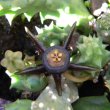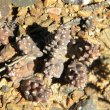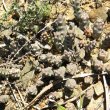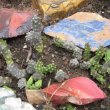Duvalia caespitosa var. caespitosa
| Botanical Name | Duvalia caespitosa var. caespitosa |
|||||||||||
| Family | Apocynaceae - The Oleander or Dogbane family. |
|||||||||||
| Pronunciation | doo-VAL-ee-uh kess-pi-TOH-suh |
|||||||||||
| Common Name(s) |
Afrikaans: Hotnotstoonjies (Hottentot's toes)
|
|||||||||||
| Plant Group |
|
|||||||||||
| Plant Size |
|
|||||||||||
| Position |
|
|||||||||||
| General Information |
|
|||||||||||
| Specific Information | Duvalia caespitosa is a Stapelia-like plant with small, succulent stems which creep along the ground, rooting as they go, to form a mat. The dull blue-green to pinkish, slightly toothed stems are densely crowded and leafless. As with many succulents, they prefer to grow in the light shade of scrubby shrubs or between rocks where they get some shade during the day. Seed pods are decorative, appearing as twin horns up to a year after flowering. The flowers are held on pinkish stems and have a pungent smell, variously compared to mature blue cheese, rotten meat, smelly socks and the like. The smell of carrion attracts flies which are known to attempt to lay their eggs on the flowers and in doing so, pollinate them. |
|||||||||||
| Ad Break | ||||||||||||
| Flowers | ||||||||||||
| Description | flattened, star shaped with five fleshy, narrow 'petals', about 3 cm in diameter |
|||||||||||
| Season |
|
|||||||||||
| Colour |
|
|||||||||||
| Growth Rate |
|
|||||||||||
| Plant Uses |
|
|||||||||||
| Distribution and Habitat | in the Eastern Cape Province in arid Karoo and semi-Karoo habitats, in rocky areas, amongst stones and in the cracks between large boulders, often shaded by scrub or grass |
|||||||||||
| Planting Suggestions | Duvalia caespitosa requires plenty of sunlight to flower successfully but does need protection from the sun's most blistering rays. Water moderately to sparingly and only when the soil is dry. They can tolerate temperatures down to 5ºC as long as they are kept dry. All the members of this family have problems with stem rot. Remove the affected stems or sections, cut off all visible rot and dry out the healthy parts for a day or two. Lay (not bury) the stems on the ground in a lightly shaded spot and they will root from the underside. The plant is easily propagated from stem cuttings. Seeds do germinate quite easily - sow in well-drained, sandy soil and barely cover the seeds. Keep slightly moist. If needed, use a fertiliser low in nitrogen as this results in an overgrowth of foliage. |
|||||||||||
| Lorraine's Garden Notes | As you can see in the last picture above, the plant has had way too much water and shade, resulting in skinny, very green stems. This is not desirable as the plant is more susceptible to disease. I really should know better! |
|||||||||||
| Medicinal Uses | No data found. |
|||||||||||
| Ad Break | ||||||||||||










Discuss this plant
Share knowledge, ask a question or give an experience.